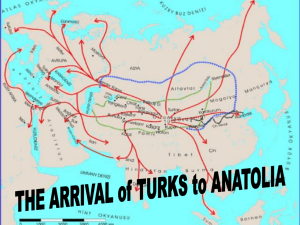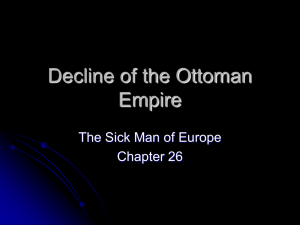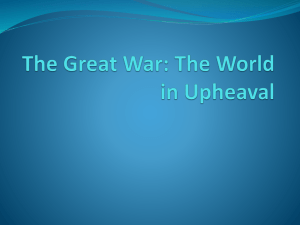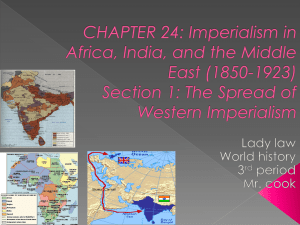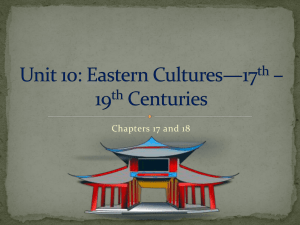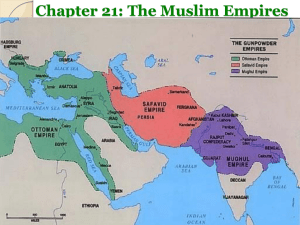Ottoman Empire
advertisement
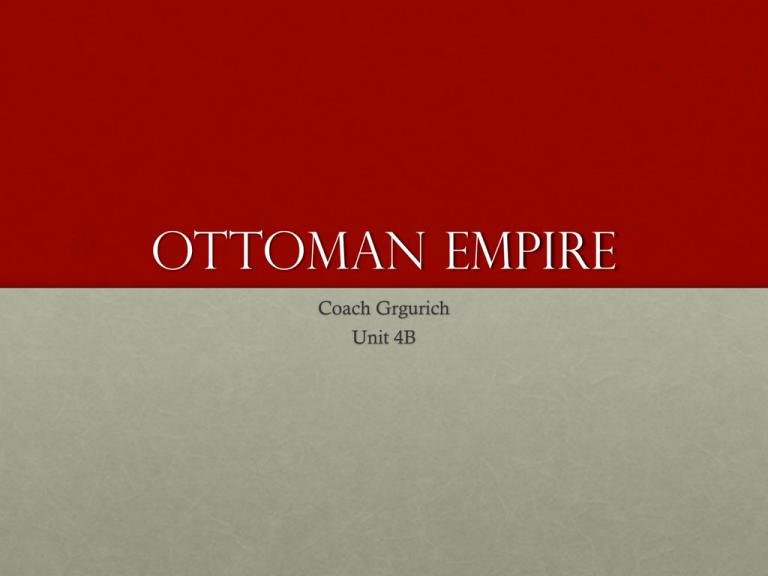
Ottoman Empire Coach Grgurich Unit 4B Background • The Ottoman Empire lasted from 1299 until the end of World War I. Beginning as a Turkish tribe, the Ottomans, ruled by an absolute monarchy, became the most powerful Muslim country in the world, with an empire reaching from southeastern Europe to north Africa. Osman I • 1299: Osman I became sultan of the Seljuk Turks after the previous sultan died. Osman reorganized the Turks' government and continued attacking the Byzantine Empire, which had been fighting with the Turks for centuries. The Ottoman Empire acquired its name from Osman. Fall of Constantinople • 1453: The Ottoman Empire captured the city of Constantinople, the capital of the Byzantine Empire. The fall of Constantinople to the Ottoman Turks marked the end of the Byzantine Empire, which had existed for over one thousand years. Constantinople, renamed Istanbul, became the Ottomans' capital city. Control of Istanbul was significant because it was at the crossroads of trade between Europe and Asia. Since water and overland routes passed through Istanbul, it was a very important location. Suleiman I • 1520: Suleiman I became sultan of the Ottoman Empire, ruling it until 1566. During his reign, Suleiman strengthened the military, was known as a fair ruler, and supported the arts. He reorganized the Ottoman legal system, for which he became known as "The Lawgiver." Suleiman also conquered lands in the eastern Mediterranean and North Africa. Because of all these feats, he is remembered as Suleiman the Magnificent. Muslim Expansion • The Ottoman Empire expanded after the capture of Constantinople. The Ottomans changed the name of the city to Istanbul, and it became their capital city. • The empire included the Mediterranean coastline of North Africa, parts of eastern Europe, Turkey, and the coastal areas of the Middle East. Expansion Con’t • An elite corps of Ottoman army officers known as janissaries existed from the 14th to 19th centuries. The janissaries were young, Christian boys from the conquered land of the Balkans. The boys received extensive military training. • The Ottoman Empire's navy was very powerful, helping to capture much of the coastline. The army invaded eastern Europe and parts of central Europe. The invasions caused Europeans to search for alternative sea routes to Asia. Ottoman expansion was finally stopped at the Siege of Vienna, in 1529. Spread of Muslim Culture • Through trade and the Muslim conquests, the religion of Islam was spread. • Because the Qur'an was only written in Arabic, language was one aspect of Islam that was spread along with religious practices. • Literature was also spread; stories from the Arabian Peninsula and Turkey traveled throughout the Mediterranean. • People living in areas conquered by the Ottoman Empire had some religious freedom; however, those who did not practice Islam had to pay higher taxes. Military Engagements • The Safavid Empire emerged to the east of the Ottoman Empire, in the 1500s. Both the Ottomans and the Safavids were Muslim empires, but the Ottomans followed the Sunni branch of Islam and the Safavids followed the Shiite branch of Islam. The empires often fought for control of land that is now part of modern day Iraq and Iran. Military Con’t • The Battle of Lepanto was a significant naval battle that took place off of the coast of Greece in 1571. Spain and other Christian states united and defeated the Ottomans, it was the first time a Christian force defeated an Ottoman force. • In 1529, the Ottoman army attacked the city of Vienna, Austria, beginning the Siege of Vienna. After one month of battle, the Turkish forces withdrew from Vienna, stopping further advancement of Islam into Europe. Trade • Many trade routes of Asia, Africa, and the Middle East went through areas under Ottoman rule. • Many goods were traded along these routes, including silk, spices, paper, steel, and crops. • Because the Ottomans controlled the trade routes that connected Europe with Asia, Europeans began looking for new sea routes to Asia. Siege of Vienna • 1683: The Ottomans and Austrian Habsburgs engaged in war on and off for over a century in the years leading up to the Siege of Vienna. They were fighting primarily over control of territory in Hungary and the Balkans. The Siege of Vienna resulted in a victory for the Habsburgs, and subsequent battles resulted in the Ottomans ceding lands to the Austrians in 1699. Decline • 1700s: The Ottoman Empire began to weaken. In 1699, the Empire surrendered territory for the first time in its history, losing some land to Austria. It continued to decline up to the early 20th century. • 1918: Allied nations defeated the Ottoman Empire in World War I. The Ottoman Empire had joined the Central Powers with Germany, Austria-Hungary, and Bulgaria, but the war left it devastated. An Arab revolt tore the Middle East out of Ottoman control, and Turkey itself was invaded by the Allied Powers. Mustafa Kemal • 1923: Mustafa Kemal established the Republic of Turkey in Anatolia, where the Ottoman Empire had been centered. Kemal had been an officer in World War I who helped the Ottomans win the Battle of Gallipoli. When World War I ended, parts of Turkey were divided between the British, French, and Greeks. Kemal led the Turkish National Movement and the Turkish War of Independence against these foreign armies. He moved the capital from Istanbul to Ankara, and he abolished the position of sultan in 1922, officially ending the Ottoman Empire. He was given the name "Atatürk," which means "father of the Turks", and he became the first president of Turkey.

